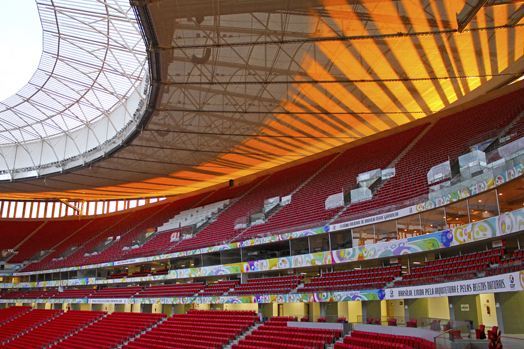IAnD Exclusive
Design Blast FIFA
Design Blast FIFA
By Anurag Pandey
Photography: Courtesy the architect
.gif) |
| . |
The National Stadium of Brasilia ‘Mane Garrincha’ is a modern arena that
can receive any duel on the planet!
Speaking about the challenge, architect of the stadium Vincent de Castro
Mello informs, “The challenge was to devise an arena that nestled in the heart
of the capital, and could maintain the architectural line that made Brasilia a
World Heritage Site.”
.jpg) |
| . |
Predictably, Mane Garrincha is the new architectural landmark in the
city and the second largest arena of Brazil with a preoccupied design
concentrating on economic and environmental sustainability. Referred to as an
Eco arena, the design model could prove to be adopted in future World Cups too.
.jpg) |
| . |
The only sports stadium in the world awaiting the LEED Platinum Seal,
its highlight is its polytetrafluoroethylene (PTFE) and titanium dioxide (TiO2)
coated fabric membrane roof, which in addition to offering protection from sun
and rain, has the ability to break down and absorb nitrogen oxides in the
atmosphere, arising mainly from vehicular traffic, thereby controlling the
environment.
 |
| . |
Additionally, the roof is fitted out with rooftop photovoltaics for
conversion of solar energy into electrical energy, dual solar reflecting UV
rays and allows the passage of stray light inside the stadium maximizing natural
light and commendably reducing energy consumption. Besides the innovative
roofing, the landscape design offers more than 6,500 different species of trees
and has turned the vicinity of the stadium into a veritable green museum zone.
Rainwater harvesting, replenishing the ground-water table and other ‘green’
components also abound.
.jpg) |
| . |
.jpg) |
| . |
Continuing its unique application into the interiors, the slopes of the
stands are angled to ensure 100% visibility from every single seat and the
stadium seats no less than 71,000! The
physical separation of the "bowl" area, bleachers and external
terrace areas with ramps is purposeful. All passages, ramps, exits, hallways
comply with set safety standards with runoff and maximum time of 8 minutes to
the entire stadium.
.gif) |
| . |
On the terrace are located 288 concrete pillars that sustain the
compression ring and the concrete roof structure; whereas the structure of the
stands is on the inside of the big ring but not touching, to facilitate
independent movement. This solution allows for thermal comfort at the stadium
since it allows cross circulation of free air at the top of the bleachers.
.jpg) |
| . |
Interestingly the free column inspiration is one that pays a silent
tribute to the open architecture of Brasilia, a majority of which is attributed
to none other than Brazil’s master architect Oscar Niemeyer.

No comments :
Post a Comment